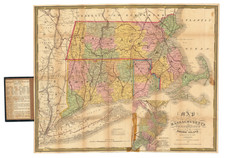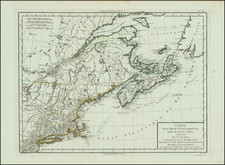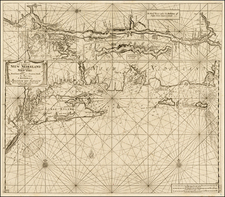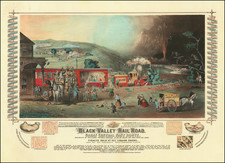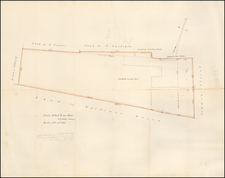Hub of the Carriage Industry
Finely executed birdseye view of Merrimac, Massachusetts, published in by George Norris in Brockton, Massachusetts in 1889,
The view offers a sprawling look at vibrant New England town on the Merrimac River, at the apex of its importance in the Carriage Manufacturing industry.
Notable locations in the town are numbered and written below so one can quickly identify their location. Two small insets show the east side of Merrimack's main square and Poyen & Company's block on the north side of Main Street, which had been built buy John S. Poyen and his partner in 1886, to house their carriage finding business. Poyen was a major supplier of carriage hardware and finishing trims. The business was founded in the 1850s in Merrimac by John Poyen, Sr. It grew to include two large brick business blocks, one in Merrimac, and one at 77 Elm Street in neighboring Amesbury.
Merrimac, Massachusetts
Merrimac, Massachusetts was originally part of the Merrimack Plantation established in 1638, which included present-day Salisbury, Amesbury, and Merrimac. By 1668, Amesbury became a separate town, and the area that would later become Merrimac was initially known as West Parish, later called West Amesbury.
West Amesbury was a local port by the mid-1800s, with boats traveling to Newburyport carrying goods downriver and returning with essential supplies. Notably, chaise makers such as Michael Emery, William Little, and Stephen Bailey operated in the 1700s, but by the 19th century, four-wheeled carriages like landaus and broughams had begun to replace the two-wheeled chaise.
On May 17, 1876, West Amesbury was officially renamed Merrimac, which means "swift water place" in the indigenous language of the region. The separation from East Amesbury (now Amesbury) was significantly influenced by differences in the production philosophies of carriage-making firms in both areas. While East Amesbury mass-produced more affordable carriages, Merrimac's manufacturers concentrated on high-quality, specialized items. By 1888, Merrimac was home to nineteen carriage-making shops, including J.B. Judkins and Company, Loud Brothers, and H.G. & H.W. Stevens Carriage Works. According to the Massachusetts Gazetteer of 1890, some 500 men were engaged in this industry.
Complementary businesses thrived in Merrimac. G.W. J. Murphy produced "Murphy Buttons," which were brass fasteners used in attaching curtains to carriages. John Poyen and Herbert Delano owned a well-stocked carriage-finding store, supplying essential materials like threads, ribbons, needles, and fringes. Among the principal manufacturers, J.B. Judkins Company was preeminent. Established in 1857 by John B. Judkins and Isaac B. Little, it produced top-quality carriages and was honored with a gold medal at the 1876 Centennial Exposition in Philadelphia. By 1892, sensing the decline in the carriage industry, the company pivoted towards the manufacture of automobile bodies for the Electric Vehicle Company of Hartford, Connecticut.
Merrimac's carriage-making ceased in 1910. J.B. Judkins became a major employer, shifting its focus to high-quality automobile bodies for companies like Pierce Arrow, Lincoln Cadillac, and Packard.
Rarity
The view is rare on the market. We note examples in the Boston Public Library and Library of Congress.









